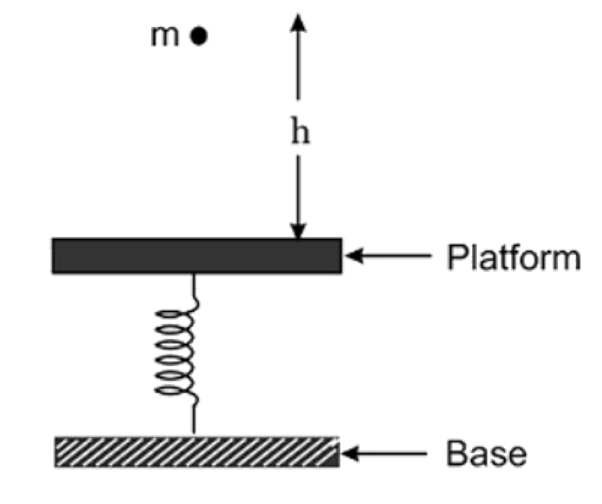A 242×104kg freight car moving along a horizontal rail road spur track at 7.2 km/hour strikes a bumper whose coil springs experiences a maximum compression of 30 cm in stopping the car. The elastic potential energy of the springs at the instant when they are compressed 15 cm is
12.1×104 joules
121×104 joules
1.21×104 joules
1.21×106 joules
The correct Answer is:B, D
Step by step video, text & image solution for A 242 × 10^(4)kg freight car moving along a horizontal rail road spur track at 7.2 km/hour strikes a bumper whose coil springs experiences a maximum compression of 30 cm in stopping the car. The elastic potential energy of the springs at the instant when they are compressed 15 cm is by Physics experts to help you in doubts & scoring excellent marks in Class 12 exams.
Updated on:21/07/2023Topper's Solved these Questions
- WORK, POWER & ENERGY BOOK - MOTIONCHAPTER - WORK, POWER & ENERGY EXERCISE - Exercise - 3 Section-A
25 Videos
- WORK, POWER & ENERGY BOOK - MOTIONCHAPTER - WORK, POWER & ENERGY EXERCISE - Exercise - 3 Section-B
22 Videos
- WORK, POWER & ENERGY BOOK - MOTIONCHAPTER - WORK, POWER & ENERGY EXERCISE - Exercise - 1
42 Videos
- WAVESBOOK - MOTIONCHAPTER - WAVESEXERCISE - EXERCISE -4 (Level -II) (previous year JEE Advanced)
10 Videos
Similar Questions
A mass of 5 kg is attached to the free end of a spring pulled sideways to a distance of 3 cm and released. What will be the

(a) Speed of this mass when spring is compressed by 2 cm ?
(b) Potential energy of the mass at the point where kinetic energy becomes zero ?
View SolutionTwo blocks A and B each of mass m are connected by a massless spring of natural length L and spring constant k. The blocks are initially resting on a smooth horizontal floor with the spring at its natural length. A third identical block C also of mass m moves on the floor with a speed v along the line joining A and B and collides with A. Then
The kinetic energy of the A-B system at maximum compression of the spring is mv2/4
The maximum compression of the spring v√m/3k<br>Thek∈etice≠rgyoftheA−Bsystematmaxiμmcompression<br>Themaxiμmcoppressionofthespr∈gisvsqrt(m//k)
View Solution
Knowledge Check
A 2 kg block slides on a horizontal floor with a speed of 4 m/s. It strikes an uncompressed spring, and compresses it till the block is motionless. The kinetic friction force is 15 N and spring constant is 10000 N/m. The spring is compressed by (in cm):
A2.5B11.0C8.5D5.5Consider, a car moving along a straight horizontal road with a speed of 72 km/h. If the coefficient of static friction between the distance in which the car can be stopped is (Take g=10/s2)
A30mB40mC72mD20mA spring of force constant 600Nm−1 is mounted on a horizontal table. A mass of 1.5 kg is attached to the free end of the spring,pulled sideways to a distance of 2 cm and released . The speed of the mass when the spring is compressed by 1 cm is
A0.175ms−1B0.35ms−1C0.7ms−1D1.4ms−1
A block of mass M = 4 kg is kept on a smooth horizontal plane. A bar of mass m = 1 kg is kept on it. They are connected to a spring as shown & the spring is compressed. Then what is the maximum compression in the spring for which the bar will not slip on the block when released if coefficient of friction between them is 0.2 & spring constant = 1000 N/m : (Take g=10m/s2)

View SolutionA spring of force constant 1200Nm−1 is mounted on a horizontal table as shown in figure. A mass of 3.0kg is attached to the free end of the spring, pulled side ways to a distance of 2.0cm and released , what is
(a) the speed of the mass when the spring is compressed by 1.0cm?
Potential energy of the mass when it momentarily comed to rest ?
(c) Total energy of the oscillating mass.

View SolutionA particle of mass m=1kg is dropped from a height h=40cm on a light horizontal platform fixed to one end of an elastic spring, the other being fixed to a base, as shown in the diagram. The particle collides with the platform and sticks to it. As a result, the spring is compressed by an amount x=10cm. What is the force constant of the spring?
(Take g=10ms−2)

View SolutionConsider a car moving along a straight horizontal road with a speed of 72 km / h . If the coefficient of kinetic friction between the tyres and the road is 0.5, the shortest distance in which the car can be stopped is [g=10ms−2]
View SolutionConsider a car moving along a straight horizontal road with a speed of 36 km/h. If the coefficient of static friction between road and tyers is 0.4, the shortest distance in which the car can be stopped is (Take g=10m/s2)
View Solution